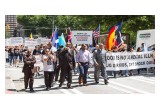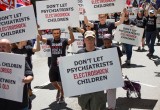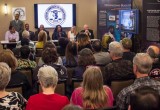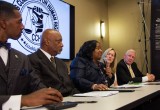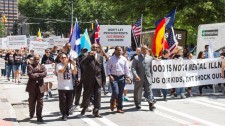
At the annual convention of the American Psychiatric Association in Atlanta, Georgia, diverse organizations including the Nation of Islam, NAACP, Black Lives Matter, 10,000 Fearless Men and Concerned Black Clergy joined CCHR (Citizens Commission on Human Rights) in a demonstration to demand the ban of shock treatment on children.
Atlanta, Georgia, May 17, 2016 (Newswire.com) - When the international mental health watchdog Citizens Commission on Human Rights (CCHR) took a stand at the annual convention of the American Psychiatric Association (APA) against the use of electroshock on children, it was joined by representatives of the NAACP, the Nation of Islam, 10,000 Fearless Men, Black Lives Matter and Concerned Black Clergy.
Electroconvulsive Therapy, otherwise known as ECT or electroshock treatment, is a technique invented in the 1930s that sends massive amounts of electricity into the brain to induce a seizure.
"There are no indications for the use of ECT on minors, and hence this should be prohibited through legislation."
World Health Organization
Protesters reported that bystanders were shocked to learn this practice is still common and stunned to learn that the APA is currently pressuring the Food and Drug Administration to reclassify ECT devices to include their use against children.[2]
“You mean they still do that?” asked one of the security guards where the APA convention took place. “I thought that went out in the ‘40s.”
Not so, says Mental Health America, reporting that “ECT is administered to an estimated 100,000 people a year, primarily in general hospital psychiatric units and in psychiatric hospitals.”[3]
The FDA is aware of the danger of ECT. In fact, the FDA's Office of Device Evaluation, part of the Center for Devices and Radiological Health, issued a draft guidance in early 2016 recommending a “prominently placed” warning on ECT devices to include “The long-term safety and effectiveness of ECT treatment has not been demonstrated.”[4]
The same report lists effects known to be associated with ECT, ranging from:
Long-term problems with "autobiographical memory" (knowledge about one's own life)
Pain and skin burns
Insufficient, or lack of breathing
Heart attack
Stroke
Death
The march was followed by a panel discussion on ECT, and a symposium the following day that presented such compelling information, the only question that remained was “Why on Earth would anyone in their right mind push to use this against children?”
One speaker, an ECT survivor who received 30 rounds of electroshock the year he was 21, doesn’t have a single memory of his high school years. He broke into tears while recounting “sitting there, and my father having to teach me how to tie my shoes again.”
“It is unconscionable to even consider doing this to a child,” said Dr. Linda Lagemann, a clinical psychologist, retired after 23 years in practice. “Someone’s getting rich and someone’s getting hurt. This really must be stopped.”
Atlanta native, Georgia State Senator Donzella James, spoke on the panel on the need for state legislation to ban the use of ECT on children. She said Georgia’s provisions to protect children and others from ECT are grossly insufficient. She cited a World Health Organization recommendation to governments that “There are no indications for the use of ECT on minors, and hence this should be prohibited through legislation.”[5]
Panel Member Rev. Fred Shaw commented on the unanimous, resounding and spontaneous support for Senator James’ proposal, and that this issue brings together this particular mix of people of every persuasion, religious affiliation and socioeconomic delineation, showing that when it comes to our children, we can find unity amongst diversity.
CCHR is a non-profit, non-political, non-religious mental health watchdog established in 1969 by the Church of Scientology and professor of psychiatry Dr. Thomas Szasz. Its mission is to eradicate abuses committed under the guise of mental health and enact patient and consumer protections. CCHR has helped to enact more than 150 laws protecting individuals from abusive or coercive mental health practices.
Click here for more information.
References:
[1] "Electroconvulsive Therapy (ECT) Devices for Class II Intended Uses," Draft Guidance for Industry, Clinicians and Food and Drug Administration Staff, December 29, 2015, pp. 13-14, fda.gov/downloads/MedicalDevices/UCM478942.pdf.
[2] Letter to Robert M. Califf, M.D., Commissioner, U.S. Food and Drug Administration, from the American Psychiatric Association, March 10, 2016, p. 2, psychiatry.org/psychiatrists/advocacy/federal-affairs/patient-safety, click on: "March 10: APA Comments to the FDA Concerning the Proposed Order and Draft Guidance related to ECT Devices."
[3] "Electroconvulsive Therapy (ECT)," Mental Health America, psychiatry.org/psychiatrists/advocacy/federal-affairs/patient-safety.
[4] Op. cit., "Electroconvulsive Therapy (ECT) Devices for Class II Intended Uses," Draft Guidance for Industry, Clinicians and Food and Drug Administration Staff.
[5] Benedetto Saraceno, MD, "WHO RESOURCE BOOK ON MENTAL HEALTH, HUMAN RIGHTS AND LEGISLATION WHO 2005," p. 64, who.int/mental_health/policy/legislation/Resource%20Book_Eng2_WEB_07%20(2).pdf.
Source: ScientologyNews.org
Share:

